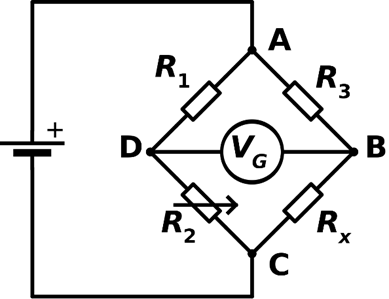What are the advantages of the null-point method in a Wheatstone bridge? What additional measurements would be required to calculate Runknown by any other method?
A Wheatstone stone bridge helps to determine an unknown resistance by placing it with three other known resistances in a manner where it is balanced. This is done by adjusting known resistance(R2) to a point where no current flows in the arm BD.
At this point, there is no potential difference between points B and D and thus no current flows through the galvanometer VG. The advantage of this method is that we surpass or cancel out the presence of galvanometer and do not account for its internal resistance and current flowing. So the galvanometer does not affect the balance point and hence the measurement.
Kirchhoff’s rules can be applied to such circuits to determine Runknown. But here, we need to take into account the current flowing in all arms, including the galvanometer.